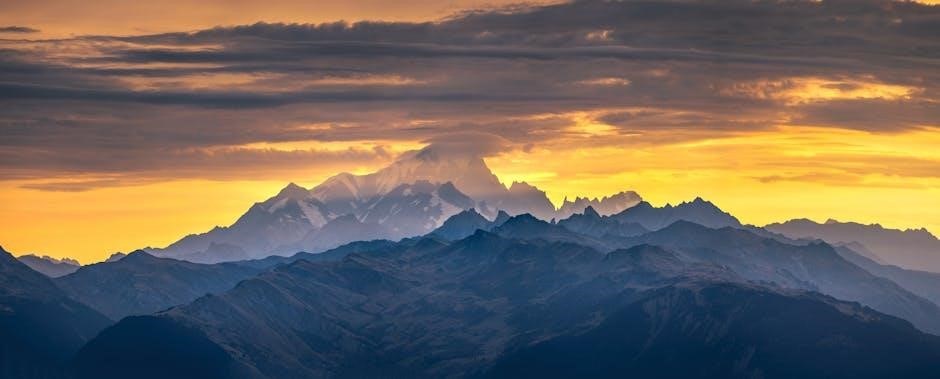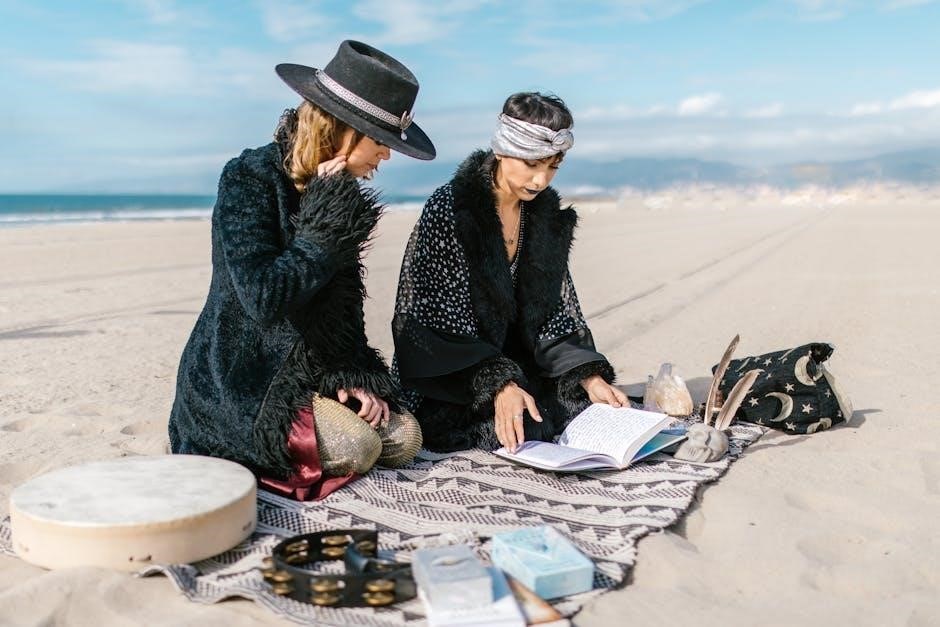Tour du Mont Blanc Self-Guided: A Comprehensive Guide
Embark on a self-guided Tour du Mont Blanc (TMB) adventure! This comprehensive guide provides essential information for independent mountain walkers. Discover the majestic Mont Blanc massif‚ traverse stunning landscapes‚ and experience the thrill of completing this iconic European trek at your own pace. Customize your journey!
What is the Tour du Mont Blanc (TMB)?
The Tour du Mont Blanc‚ often abbreviated as TMB‚ is a renowned long-distance hiking trail that encircles the Mont Blanc massif‚ the highest peak in the Alps. This iconic trek spans approximately 170 kilometers (105 miles)‚ traversing through three countries: France‚ Italy‚ and Switzerland. The TMB is celebrated for its breathtaking scenery‚ diverse landscapes‚ and cultural immersion‚ drawing hikers from around the globe.
The trail typically takes 10 to 12 days to complete‚ with daily ascents and descents accumulating to around 9‚000 meters (29‚500 feet) in total elevation gain. The route winds through picturesque valleys‚ crosses challenging mountain passes‚ and offers stunning views of glaciers‚ alpine meadows‚ and charming villages.
Hikers along the TMB experience a unique blend of natural beauty and cultural richness. Each day brings new vistas and opportunities to explore local traditions‚ sample regional cuisine‚ and interact with fellow trekkers. The TMB is more than just a hike; it’s an unforgettable journey through the heart of the Alps‚ offering a profound connection with nature and a sense of accomplishment. Whether you choose a guided tour or a self-guided adventure‚ the TMB promises an experience of a lifetime.
Why Choose a Self-Guided TMB Trek?
Opting for a self-guided Tour du Mont Blanc trek offers a unique sense of freedom and flexibility. You have the liberty to tailor your itinerary‚ choosing your own pace‚ selecting accommodations that suit your preferences‚ and lingering longer in spots that capture your heart. This independence allows for a deeper connection with the environment and a more personalized experience.
Self-guided treks often prove more cost-effective than guided tours‚ as you eliminate the expense of a guide. You can carefully budget for accommodations‚ meals‚ and transportation‚ making the TMB accessible to a wider range of travelers. Detailed maps‚ guidebooks‚ and GPS tracks are readily available‚ empowering you to navigate the trail confidently.
For experienced hikers comfortable with route finding and basic navigation‚ a self-guided TMB trek presents an exciting challenge and a chance to test your skills. It’s an opportunity to immerse yourself in the alpine environment‚ relying on your own abilities and resourcefulness. The sense of accomplishment upon completing the circuit is amplified by the knowledge that you navigated the route independently‚ making it a truly rewarding adventure. The beauty of the TMB is yours to discover‚ on your terms.
Is a Self-Guided TMB Trek Right for You?
Before embarking on a self-guided Tour du Mont Blanc (TMB) trek‚ honestly assess your experience and skills. Are you a seasoned hiker comfortable with multi-day treks‚ navigating challenging terrain‚ and reading maps? The TMB involves significant elevation gains and losses‚ demanding physical fitness and endurance. Consider your ability to handle unpredictable weather conditions‚ as mountain weather can change rapidly.
Do you possess strong navigation skills and experience using maps‚ compasses‚ or GPS devices? While the TMB is well-marked‚ the ability to confidently find your way is crucial. Are you comfortable making independent decisions and problem-solving on the trail? Self-reliance is key‚ as you won’t have a guide to assist you with logistical issues or unexpected challenges.
If you’re new to long-distance hiking or lack confidence in your navigation skills‚ a guided TMB trek might be a better option. However‚ if you’re an experienced and independent hiker seeking a challenging and rewarding adventure‚ a self-guided TMB trek could be the perfect fit. Carefully weigh your abilities and preferences before making a decision to ensure a safe and enjoyable experience. The TMB awaits‚ but preparation is paramount.

Best Time to Hike the TMB Self-Guided
The optimal window for a self-guided Tour du Mont Blanc (TMB) trek is typically from late June to mid-September. During these months‚ the trails are generally snow-free‚ and the weather is most favorable for hiking. However‚ it’s essential to remember that mountain weather can be unpredictable‚ even during the peak season.
Late June and early July offer the advantage of fewer crowds‚ but some higher passes may still have lingering snow patches. Wildflowers are also in full bloom during this period‚ adding to the scenic beauty. July and August are the busiest months‚ with warmer temperatures and longer daylight hours. Be prepared for more crowded trails and potentially higher accommodation prices.
September provides a sweet spot with fewer hikers and stunning autumn foliage. The weather is generally still pleasant‚ although temperatures may start to cool down‚ especially at higher elevations. Hiking in late September carries a slightly higher risk of encountering early snowfall‚ so it’s crucial to monitor weather forecasts closely. Ultimately‚ the best time to hike the TMB depends on your preferences and tolerance for crowds‚ weather conditions‚ and trail accessibility;
Essential Gear and Packing List for a Self-Guided TMB Trek
Packing appropriately is crucial for a successful and enjoyable self-guided TMB trek. Start with sturdy‚ broken-in hiking boots that provide excellent ankle support. Invest in high-quality hiking socks to prevent blisters. Layering is key for clothing: pack moisture-wicking base layers‚ fleece or insulated mid-layers‚ and a waterproof and windproof outer shell.
Essential gear includes a comfortable backpack (40-60 liters)‚ trekking poles for stability‚ a headlamp with extra batteries‚ and a reusable water bottle or hydration reservoir. Don’t forget sunscreen‚ sunglasses‚ and a hat for sun protection. A first-aid kit with blister treatment‚ pain relievers‚ and antiseptic wipes is a must.
Navigation tools are vital: bring a detailed map‚ compass‚ and GPS device or smartphone with GPS capabilities. Download offline maps and familiarize yourself with the route. Other important items include a lightweight sleeping bag liner (for refuges)‚ a travel towel‚ insect repellent‚ and a portable charger for electronic devices. Pack light to minimize strain on your body during long days of hiking. Consider the season and weather forecast when making your final packing decisions.
Navigation and Route Finding on the TMB

Navigating the Tour du Mont Blanc self-guided requires careful preparation and attention to detail. The TMB is generally well-marked‚ but relying solely on trail markers can be risky. Familiarize yourself with the route before you go‚ studying maps and guidebooks thoroughly. A detailed topographic map is essential for understanding the terrain and identifying landmarks.
A compass is a valuable tool for confirming your direction‚ especially in foggy or snowy conditions. Consider using a GPS device or smartphone with GPS capabilities to track your progress and pinpoint your location. Download offline maps to your device in case of limited cell service. Pay close attention to trail markers‚ which are typically red and white blazes painted on rocks and trees;
Be aware that trail conditions can change due to weather or maintenance. Stay informed about potential hazards and alternate routes. If you’re unsure about the correct path‚ consult your map and compass or GPS. It’s always better to err on the side of caution and retrace your steps if necessary. Practice your navigation skills before your trek to ensure you’re comfortable using your chosen tools.
Accommodation Options Along the TMB
The Tour du Mont Blanc offers a variety of accommodation options to suit different budgets and preferences. Refuges‚ also known as mountain huts‚ are the most common type of accommodation along the trail. They provide basic dormitory-style rooms‚ meals‚ and a social atmosphere. Booking refuges in advance is highly recommended‚ especially during peak season.
Gîtes are similar to refuges but are often smaller and more family-run. They may offer private rooms in addition to dormitories. Hotels are available in some of the larger towns and villages along the TMB‚ providing more comfort and amenities. Camping is also an option‚ but it is restricted in certain areas. Check local regulations before setting up camp.

Consider your budget‚ desired level of comfort‚ and the availability of each option when planning your accommodation. Refuges and gîtes offer a more immersive experience‚ while hotels provide more privacy and convenience. Booking well in advance is crucial to secure your preferred accommodation‚ particularly during the busy summer months. Be aware that some accommodations may require cash payments.
Sample TMB Self-Guided Itinerary (10 Days)
This is a sample 10-day itinerary for a self-guided Tour du Mont Blanc trek. It can be customized based on your fitness level and preferences.
Day 1: Les Houches to Refuge du Fioux (ascent through a picturesque forest‚ summit of Prarion‚ 360-degree view‚ descent to Fioux refuge).
Day 2: Refuge du Fioux to Les Contamines (glaciers‚ Col de Tricot‚ Truc alpine pasture‚ descent to Les Contamines).
Day 3: Les Contamines to Les Chapieux (ancient Roman Road‚ Cols du Bonhomme and des Fours‚ Chapieux Valley).
Day 4: Les Chapieux to Col Chécrouit (transfer to hike start‚ Col de la Seigne‚ Aosta Valley).
Day 5: Col Chécrouit to Refuge Bonatti (descent to Courmayeur‚ Val Sapin‚ Bertone refuge‚ Frébouze glacier).
Day 6: Refuge Bonatti to La Fouly (Mont Dolent‚ Grand Col Ferret‚ Peule alpine pasture).
Day 7: La Fouly to Champex (Swiss Val Ferret‚ Champex lake).
Day 8: Champex to Trient (panoramic view from Martigny‚ Rhône Valley vineyards‚ Bisse du Trient trail).
Day 9: Trient to Le Tour (views of Chamonix Valley).
Day 10: Le Tour to Les Houches (Aiguilles Rouges Nature Reserve‚ panoramic balcony).
Day 1: Les Houches to Refuge du Fioux
Your Tour du Mont Blanc self-guided adventure begins in Les Houches! Today’s trek involves a scenic ascent leading to the Refuge du Fioux. The day starts at 9am at the Prarion car park in Les Houches. Initially‚ you’ll hike through a picturesque forest‚ gradually ascending to the summit of Prarion‚ standing at 1969 meters above sea level.
Upon reaching the summit‚ prepare to be mesmerized by a breathtaking panorama. This vantage point offers a stunning 360-degree view of the surrounding landscape‚ providing an incredible introduction to the beauty of the Mont Blanc region.
After soaking in the views from Prarion‚ you’ll embark on a peaceful descent towards the charming Refuge du Fioux. This refuge will be your home for the night‚ offering an enchanting setting to relax and rejuvenate after your first day on the TMB. The total walking time is approximately 5 hours and 30 minutes‚ with an ascent of 800 meters and a descent of 500 meters.
Day 5: Col Chécrouit to Refuge Bonatti
Day five of your self-guided TMB trek takes you from Col Chécrouit to the renowned Refuge Bonatti. The day starts with descending towards Courmayeur‚ often called the Italian Chamonix. Explore the charming alleys of its old village‚ soaking in the Italian atmosphere.
After Courmayeur‚ your route leads you towards Val Sapin‚ heading towards the Bertone refuge‚ where exceptional panoramas await you. Take some time to appreciate the stunning views from this vantage point‚ capturing the beauty of the Italian Alps.
The final destination for today is the Refuge Bonatti‚ situated at 2‚025 meters above sea level. The refuge is named in honor of the famous Italian mountaineer Walter Bonatti. From there‚ you’ll embrace the breathtaking view of the Frébouze glacier‚ gracefully stretching out before you. The total walking time is approximately 6 hours‚ with an ascent of 1‚100 meters and a descent of 1‚000 meters. Note that accommodation in the Refuge Bonatti is without luggage.
Day 7: Grand Col Ferret to La Fouly
Day seven of your self-guided Tour du Mont Blanc adventure promises a change of scenery as you traverse from the Grand Col Ferret into Switzerland‚ ultimately reaching the charming village of La Fouly. At daybreak‚ your route leads you towards the majestic Mont Dolent‚ a unique point where the borders of France‚ Switzerland‚ and Italy converge. As you hike‚ take in the stunning views of this tri-border peak.
Your primary challenge for the day is reaching the summit of the Grand Col Ferret‚ standing tall at 2‚537 meters. Upon reaching the Col‚ you will cross into Switzerland‚ leaving Italy behind. Prepare to be greeted with the warmth of the Swiss Alps as you descend.
The descent from Grand Col Ferret is gradual‚ taking you through the picturesque Peule alpine pasture. As you walk‚ enjoy the idyllic Swiss countryside. Your destination for the day is La Fouly‚ a charming little village nestled at 1‚600 meters in the heart of the beautiful Valais region. The total walking time is approximately 6 hours 30 minutes‚ with an ascent of 900 meters and a descent of 1‚300 meters. Tonight’s accommodation is at an inn in La Fouly.
Budgeting for a Self-Guided TMB Trek
Planning a self-guided Tour du Mont Blanc (TMB) trek requires careful budgeting. Accommodation is a significant expense. Expect to pay between €60 to €100 per night for a dorm bed in a refuge or gîte‚ including half-board (dinner and breakfast). Private rooms‚ when available‚ will be considerably more expensive. Factor in around €20 to €30 per day for lunches‚ either purchased from shops or refuges along the trail‚ or prepared as picnics.
Transportation costs should also be considered. This includes getting to and from the TMB starting point (e.g.‚ Les Houches)‚ as well as any bus or cable car rides taken during the trek to shorten stages or bypass difficult sections. Budget approximately €100 to €200 for transportation‚ depending on your choices.

Additional expenses include trail maps (€15-€20)‚ guidebooks (€25-€35)‚ and any optional activities. Also‚ remember to factor in a buffer for unexpected costs‚ such as gear repairs‚ medical supplies‚ or extra food and drinks. A realistic daily budget for a self-guided TMB trek ranges from €80 to €150 per person‚ per day‚ depending on your accommodation preferences and spending habits. This excludes initial gear purchases.
